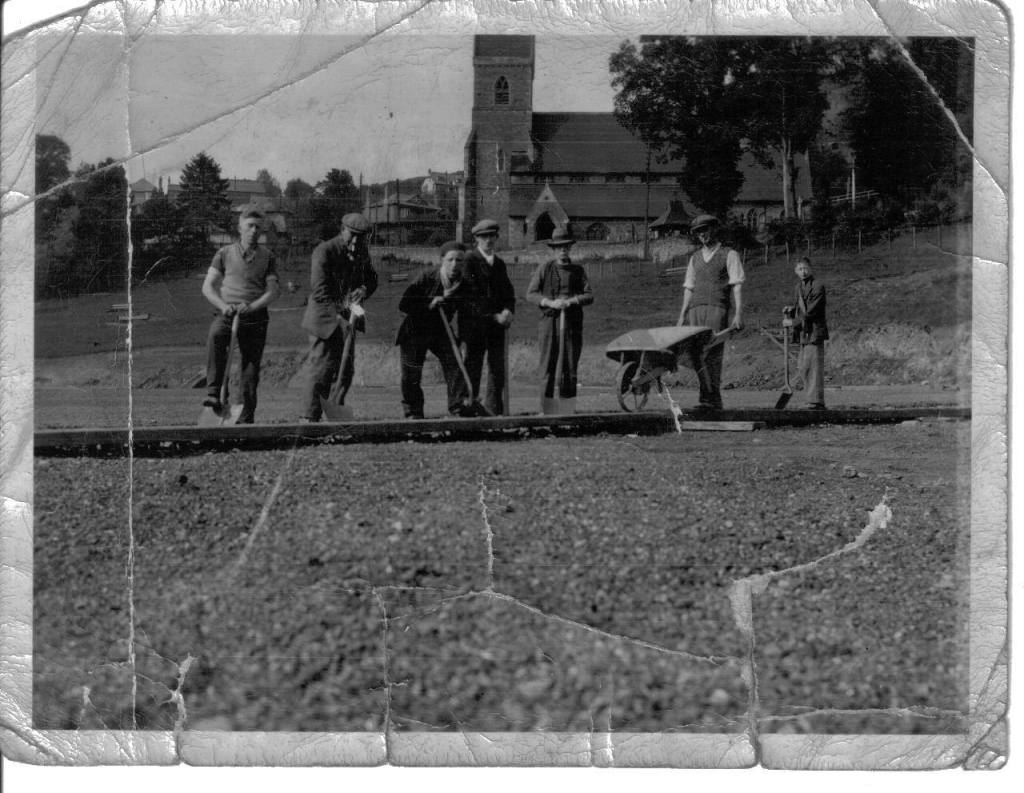How the men of Lydbrook created the Recreation Ground
During the working life of a coal mine a copious amount of waste is produced and the Lydbrook Deep Navigation Pit was no exception. In its operational years from 1838 to 1933 the mine produced a staggering 30,000 tons of the stuff. This redundant slag had no value and was dumped close to the entrance of the mine creating a man-made hill between the Church of Holy Jesus (built in 1851) and the main road. This hill became known as the Blue Mound. It was an eyesore and a danger to health and safety in the village.
Every day, in the school set on the opposite bank across the main road, Sydney Miles, the headmaster would sit at his desk and stare out of his window at this pile of of waste with growing irritation. At the same time he could hear the reasuring sound of the children laughing and playing in the school yard only partially mitigating his indignation. Then, one sunny day, he had a flash of inspiration: why not remove the Blue Mound and create a green playground for the miners’ children to use for generations?
Sydney Miles was a man of influence in Lydbrook. He had been instrumental in the building of the Lydbrook Memorial Hall in 1926. He immediately called a meeting to consider moving the Blue Mound by voluntary labour. The motion was carried and work began on the site in July 1934 and the foundation stone was laid by the Duke of Kent in November 1934.

To remove this menacing heap, the men of Lydbrook, mainly miners, constructed a mini railway in a spiral pattern up to the top, and ‘bogey’ carts were used on it to bring the material down. The work was carried out entirely by pick and shovel and pit carts. Once the mound had been flattened, they grassed it over and put in a football pitch (a home for Lydbrook AFC) and a recreation ground for the children of Lydbrook.

I am proud to say that my Grandfather, George (Mollie) Hunt, took part in this enterprise and can be seen in one of the photographs. He is the short man wearing a waistcoat, the third from the right, in the photograph above.
Postscript 1 (added on 5th December 2015)
The following extract is taken from ‘A Glance Back at . . . Lydbrook’
published by the Lydbrook Historical Society
The Recreation Ground was built on the site of the Blue Mound, seen in the centre of the previous two views, the spoil heap of Lydbrook Deep Level Colliery (1838-1933). Work began on the site in July 1934 and the foundation stone was laid by the Duke of Kent in November. Before work could begin, the brook running across the site was culverted by E.J.Flewelling & Son. This and the building of the surrounding stone walls, was the only paid work, everything else, including the removal of 30,000 tons, being carried out by volunteers. Carts and rails were loaned by Waterloo and Cannop Collieries. Part of the ground was completed in time for the Silver Jubilee on 6 May 1935, and Joys Green and Lydbrook Schools joined for a programme of games and sports, ending with a firework display.
To help appreciate the size of the Blue Mound, from Mr Hall’s (later Evan’s, now closed) shop doorway, Lydbrook Church could not be seen at all.
Postscript 2
The retaining wall to hold back the spoil following the removal of the Blue Mound was recently in the news when cracks started to show following flooding in Lydbrook.
Acknowledgements
I heard this story first from my Mum, Grandad and uncles (Pearl, George, John and Tony Hunt). The photographs are from a CD left to me by my uncle John. The web pages below have been essential to my research and I cannot recommend the wonderful SunGreen website highly enough.The postscript above is lifted directly from ‘A Glance Back at . . . Lydbrook’ published by the Lydbrook Historical Society (2002)
Interesting web pages (please click on link):
(a) SunGreen: The Blue Mound before levelling
(b) SunGreen: The Blue Mound after levelling
(c) SunGreen: The Blue Mound after levelling
